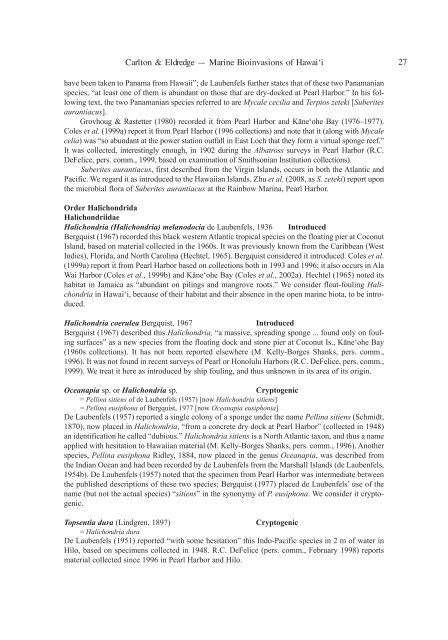bishop museum bulletins in cultural and environmental studies
bishop museum bulletins in cultural and environmental studies
bishop museum bulletins in cultural and environmental studies
Create successful ePaper yourself
Turn your PDF publications into a flip-book with our unique Google optimized e-Paper software.
Carlton & Eldredge — Mar<strong>in</strong>e Bio<strong>in</strong>vasions of Hawai‘i<br />
27<br />
have been taken to Panama from Hawaii”; de Laubenfels further states that of these two Panamanian<br />
species, “at least one of them is abundant on those that are dry-docked at Pearl Harbor.” In his follow<strong>in</strong>g<br />
text, the two Panamanian species referred to are Mycale cecilia <strong>and</strong> Terpios zeteki [Suberites<br />
aurantiacus].<br />
Grovhoug & Rastetter (1980) recorded it from Pearl Harbor <strong>and</strong> Kāne‘ohe Bay (1976–1977).<br />
Coles et al. (1999a) report it from Pearl Harbor (1996 collections) <strong>and</strong> note that it (along with Mycale<br />
celia) was “so abundant at the power station outfall <strong>in</strong> East Loch that they form a virtual sponge reef.”<br />
It was collected, <strong>in</strong>terest<strong>in</strong>gly enough, <strong>in</strong> 1902 dur<strong>in</strong>g the Albatross surveys <strong>in</strong> Pearl Harbor (R.C.<br />
DeFelice, pers. comm., 1999, based on exam<strong>in</strong>ation of Smithsonian Institution collections).<br />
Suberites aurantiacus, first described from the Virg<strong>in</strong> Isl<strong>and</strong>s, occurs <strong>in</strong> both the Atlantic <strong>and</strong><br />
Pacific. We regard it as <strong>in</strong>troduced to the Hawaiian Isl<strong>and</strong>s. Zhu et al. (2008, as S. zeteki) report upon<br />
the microbial flora of Suberites aurantiacus at the Ra<strong>in</strong>bow Mar<strong>in</strong>a, Pearl Harbor.<br />
Order Halichondrida<br />
Halichondriidae<br />
Halichondria (Halichondria) melanodocia de Laubenfels, 1936 Introduced<br />
Bergquist (1967) recorded this black western Atlantic tropical species on the float<strong>in</strong>g pier at Coconut<br />
Isl<strong>and</strong>, based on material collected <strong>in</strong> the 1960s. It was previously known from the Caribbean (West<br />
Indies), Florida, <strong>and</strong> North Carol<strong>in</strong>a (Hechtel, 1965). Bergquist considered it <strong>in</strong>troduced. Coles et al.<br />
(1999a) report it from Pearl Harbor based on collections both <strong>in</strong> 1993 <strong>and</strong> 1996; it also occurs <strong>in</strong> Ala<br />
Wai Harbor (Coles et al., 1999b) <strong>and</strong> Kāne‘ohe Bay (Coles et al., 2002a). Hechtel (1965) noted its<br />
habitat <strong>in</strong> Jamaica as “abundant on pil<strong>in</strong>gs <strong>and</strong> mangrove roots.” We consider float-foul<strong>in</strong>g Hali -<br />
chondria <strong>in</strong> Hawai‘i, because of their habitat <strong>and</strong> their absence <strong>in</strong> the open mar<strong>in</strong>e biota, to be <strong>in</strong>troduced.<br />
Halichondria coerulea Bergquist, 1967<br />
Introduced<br />
Bergquist (1967) described this Halichondria, “a massive, spread<strong>in</strong>g sponge ... found only on foul<strong>in</strong>g<br />
surfaces” as a new species from the float<strong>in</strong>g dock <strong>and</strong> stone pier at Coconut Is., Kāne‘ohe Bay<br />
(1960s collections). It has not been reported elsewhere (M. Kelly-Borges Shanks, pers. comm.,<br />
1996). It was not found <strong>in</strong> recent surveys of Pearl or Honolulu Harbors (R.C. DeFelice, pers. comm.,<br />
1999). We treat it here as <strong>in</strong>troduced by ship foul<strong>in</strong>g, <strong>and</strong> thus unknown <strong>in</strong> its area of its orig<strong>in</strong>.<br />
Oceanapia sp. or Halichondria sp.<br />
Cryptogenic<br />
= Pell<strong>in</strong>a sitiens of de Laubenfels (1957) [now Halichondria sitiens]<br />
= Pell<strong>in</strong>a eusiphona of Bergquist, 1977 [now Oceanapia eusiphonia]<br />
De Laubenfels (1957) reported a s<strong>in</strong>gle colony of a sponge under the name Pell<strong>in</strong>a sitiens (Schmidt,<br />
1870), now placed <strong>in</strong> Halichondria, “from a concrete dry dock at Pearl Harbor” (collected <strong>in</strong> 1948)<br />
an identification he called “dubious.” Halichondria sitiens is a North Atlantic taxon, <strong>and</strong> thus a name<br />
applied with hesitation to Hawaiian material (M. Kelly-Borges Shanks, pers. comm., 1996). Another<br />
species, Pell<strong>in</strong>a eusiphona Ridley, 1884, now placed <strong>in</strong> the genus Oceanapia, was described from<br />
the Indian Ocean <strong>and</strong> had been recorded by de Laubenfels from the Marshall Isl<strong>and</strong>s (de Laubenfels,<br />
1954b). De Laubenfels (1957) noted that the specimen from Pearl Harbor was <strong>in</strong>termediate between<br />
the published descriptions of these two species; Bergquist (1977) placed de Laubenfels’ use of the<br />
name (but not the actual species) “sitiens” <strong>in</strong> the synonymy of P. eusiphona. We consider it cryptogenic.<br />
Topsentia dura (L<strong>in</strong>dgren, 1897)<br />
Cryptogenic<br />
= Halichondria dura<br />
De Laubenfels (1951) reported “with some hesitation” this Indo-Pacific species <strong>in</strong> 2 m of water <strong>in</strong><br />
Hilo, based on specimens collected <strong>in</strong> 1948. R.C. DeFelice (pers. comm., February 1998) reports<br />
material collected s<strong>in</strong>ce 1996 <strong>in</strong> Pearl Harbor <strong>and</strong> Hilo.
















